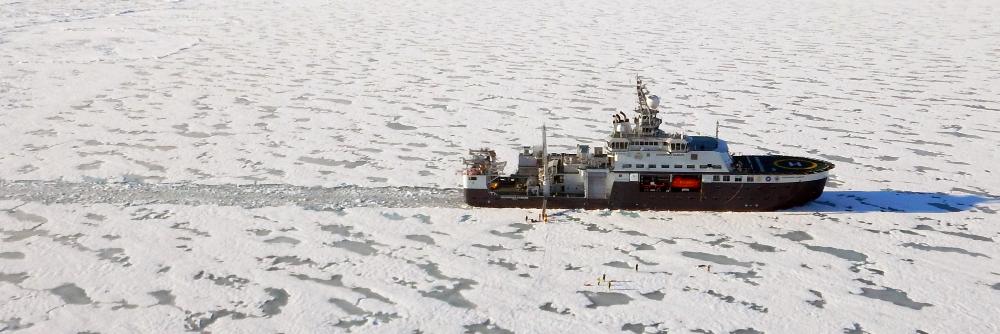
Oceans & Sea Ice NPI
@OceanSeaIceNPI
Oceanography, sea ice and atmospheric research at the Norwegian Polar Institute. Now on Bluesky: https://bsky.app/oceanseaicenpi.bsky.social
We have decided to discontinue posting about our research activities on X. Thank you for your interest and support! Please continue to follow us on Bluesky: bsky.app/profile/oceans…
🔊Do not miss our upcoming webinar on the consequences of reduced sea ice cover in the future Arctic Ocean 🗓️15 Jan. 13:00-14:00 CET 🖥️Register now: crices-h2020.eu/events
New paper in journal Tellus B from the @CRiceS_H2020 team 💪shows that bioaerosols at the North Pole , that can impact clouds ☁️, came from a local #Arctic marine source 🦠, in ice-free waters further south ... Enjoy here: doi.org/10.16993/tellu…

Consequences of reduced sea ice cover in the future Arctic Ocean 🗓️15 January-13:00 CET Aiming to improve our understanding of environmental change, the webinar will present new research on future Arctic ocean circulation with reduced sea ice Register now: crices-h2020.eu/events
Can meltwater from Antarctica trigger feedback mechanisms that accelerate melting beneath ice shelves? New model experiments from the SOFIA initiative explore this critical question: instagram.com/p/DDPDSYYILbd 📸 Morven Muilwijk (@NorskPolar )

New paper in @EGU_OS: Lauber et al. (@julzhh11, @DareliusElin, @flagneta) have evaluated 14 years of near-continuous mooring data below Fimbulisen Ice Shelf, showing that relatively warm water masses reach below the ice shelf at the ice base and at depth: doi.org/10.5194/os-20-…

This week, the polar night starts again in Tromsø. Light is vital for sea ice physics, and scientists measure how it interacts with ice. Why? Solar radiation drives seasonal sea ice changes and crucial for the ecosystem in the sea ice habitat. Read more: instagram.com/p/DC8-iM-Iapp

How different is ice just one step away? In our new study (doi.org/10.1016/j.cold…) we measured variability of ice density and strength on a meter scale. Read more here: instagram.com/p/DCrEL53oTLV


FRAMDAGEN 2024 | New scientific results from different institutes at @Framcentre were presented at Framdagen 2024, including updates from fieldwork and an outlook to a potential future Arctic Ocean from researchers at @NorskPolar. Read more: instagram.com/p/DCZHUNjI_4W

We are attending the @esa @iicwg sea ice workshop in Frascati this week, with several contributions from our group .. lot of exciting #seaice science to discuss ..



This spring our team was together with drone engineers from @NORCEresearch and researchers from @UiTNorgesarktis and @UNISvalbard. Now we are submitting our results to @esa for calibration of snow observations from space satellites. Read more here: instagram.com/p/DB1LGuoIqSs
❄️Did you know that the white on top of sea-ice is not always snow? Read why here: instagram.com/p/DBi9uyPIcs8/

Ice mass balance buoys measure vertical temperature profiles and allow for remote observation of sea ice growth and melt. NPI often use such buoys from Scottish Association for Marine Science @SAMSoceannews. Read more here: instagram.com/p/DBQr2UVIr5C

During the #SUDARCO annual meeting at @Framcentre this week, lots of new data from the Arctic Ocean were presented: instagram.com/p/DA_P2fMoeVP/.

LAST CHANCE TO APPLY for this #PhD position with a project affiliated with the iC3 Polar Research Hub: - "Ice shelf water, ocean properties and currents just north of #Antarctica floating ice shelf Fimbulisen" ic3.uit.no/job/phd-antarc… Deadline 17 October. #phdpositions
As part of the I-CRYME project, funded by @forskningsradet, researchers from @NorskPolar and other institutes are studying the impacts of the melting cryosphere on the Southern Ocean. Read more here: instagram.com/p/DAsr3iboi4s 📸 Sebastien Moreau, @polarinstituttet

The samples are back! But what happens to all the seawater we collected during this year’s @NorskPolar Arctic Ocean and Fram Strait cruise? Read more about the different analyses and collaborations here: instagram.com/p/DAbDvtBowYF (Photo: Olaf Schneider, NPI)

SOUTHER OCEAN PHYTOPLANKTON New study: - Light and iron concentrations following sea-ice melt are the main environmental factors controlling phytoplankton blooms. - Seeding by sea-ice algae may also significantly contribute. ic3.uit.no/news/phytoplan… @NorskPolar @OceanSeaIceNPI